Menus
- First class 1981
- Hercules Ultra 80 LC pulls through strongly
- Brake the Kreidler Mustang 80 with 12 fingers
- Zundapp usually stays on the heels of the Hercules
- "Hey Smoky, you’ll go all the way back afterwards, yes?"
- KTM with high quality equipment and technology
- "Was the tachometer not series?"
- Hercules Ultra 80 LC
- Kreidler Mustang 80
- Zundapp KS 80
- KTM 80 RLW
- Puch Cobra 80
- Yamaha RD 80 MX
- Honda MT-8
- The cult in words and pictures
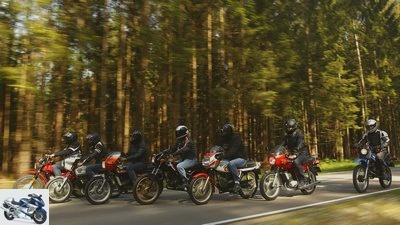
www.bilski-fotografie.de
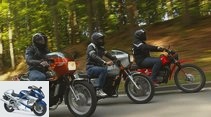
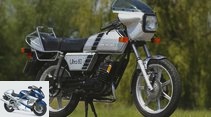
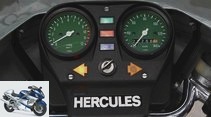
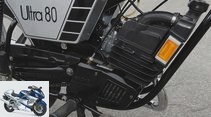
49 photos
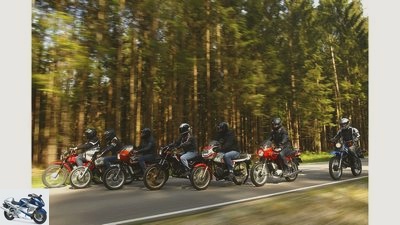
www.bilski-fotografie.de
1/49
In the footsteps of yesteryear: Hercules Ultra 80 LC, Kreidler Mustang 80, Zuendapp KS 80, Honda MT 8, Yamaha RD 80 MX, KTM 80 RLW and Puch Cobra 80.
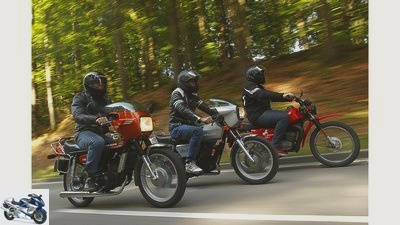
www.bilski-fotografie.de
2/49
The large German manufacturers benefit from their experience with 50 series mopeds, but were all particularly expensive.
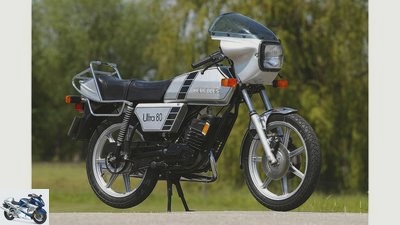
www.bilski-fotografie.de
3/49
Not all fans of the popular 50s great ultra could get used to the angular, almost chunky design of the 80s.
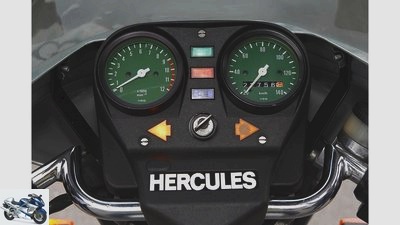
www.bilski-fotografie.de
4/49
The wildly wriggling hands of the VDO instruments often only give an idea of the true value.
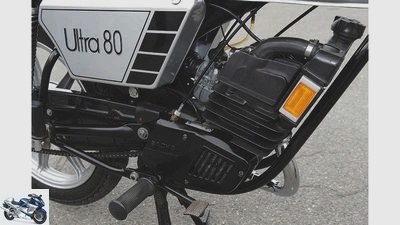
www.bilski-fotografie.de
5/49
The water-cooled Sachs engine, installed in thousands, stands for full performance, reliability and good parts supply.
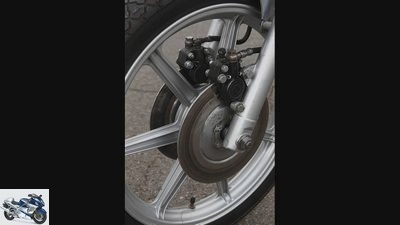
www.bilski-fotografie.de
6/49
The double disc brake is an equipment highlight.
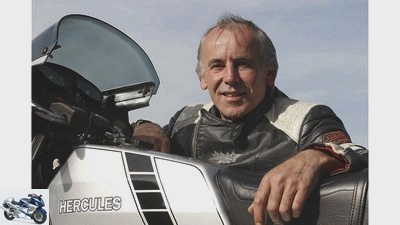
www.bilski-fotografie.de
7/49
Richard Heinzlmeier is the owner of the Hercules Ultra 80 LC.
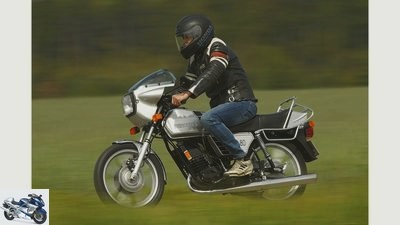
www.bilski-fotografie.de
8/49
In his youth it was a special experience to take a seat on the Hercules as a pillion passenger.
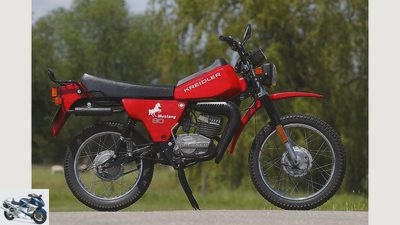
www.bilski-fotografie.de
9/49
A long-legged, massive enduro with a standing cylinder – many Kreidler fans had to get used to it.
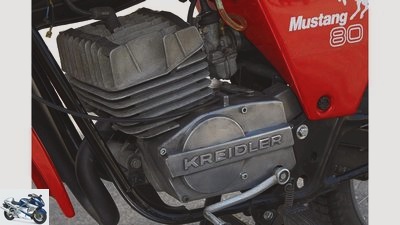
www.bilski-fotografie.de
10/49
In the new, air-cooled 80s engine with vertical cylinder, numerous parts of the 50s moped are used.
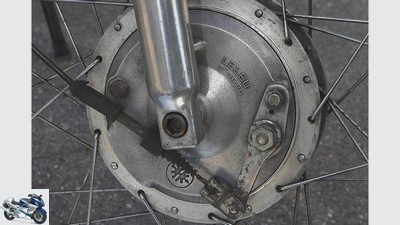
www.bilski-fotografie.de
11/49
Not that small at all, but not that effective at all – the drum brake at the front could offer more bite.
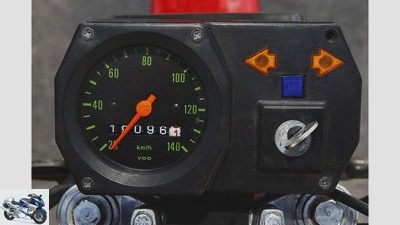
www.bilski-fotografie.de
12/49
In view of the high price that Kreidler charged for the Mustang 80, the cockpit should have been a little more luxurious.
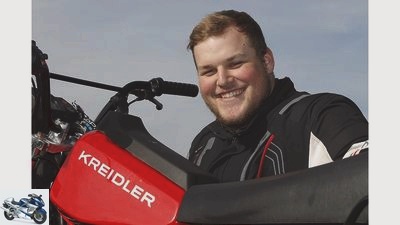
www.bilski-fotografie.de
13/49
Yannic Sauer is the owner of the Kreidler Mustang 80.
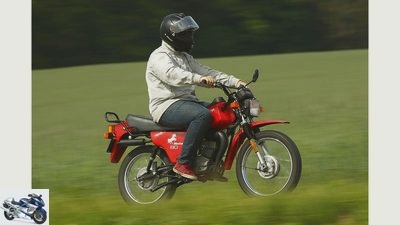
www.bilski-fotografie.de
14/49
"With a different exhaust and a slightly modified carburettor, the admittedly somewhat hard and hearty vibrating 80s Kreidler runs quite well"
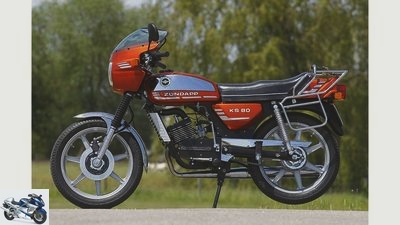
www.bilski-fotografie.de
15/49
The sporty, elegant lines are right, the available lacquer variants, here the gold orange, look noble.
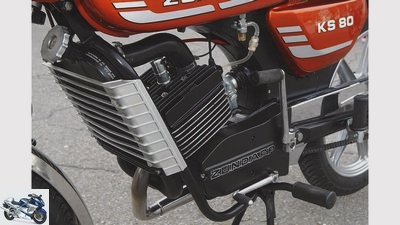
www.bilski-fotografie.de
16/49
The completely redeveloped 80s engine had to complete many thousands of tough test kilometers. The result: a reliable, powerful and well-engineered engine.
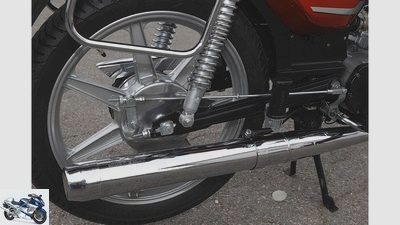
www.bilski-fotografie.de
17/49
The easy to dose and effective drum in the back deserves praise,…
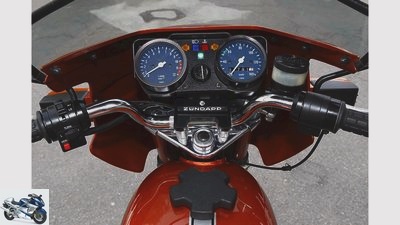
www.bilski-fotografie.de
18/49
…as well as the complete cockpit and the easy-to-use switches.
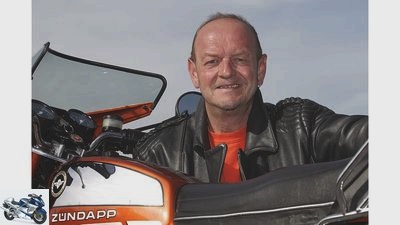
www.bilski-fotografie.de
19/49
Robert Bauer owns a whole collection of Zundapp KS 80 models.
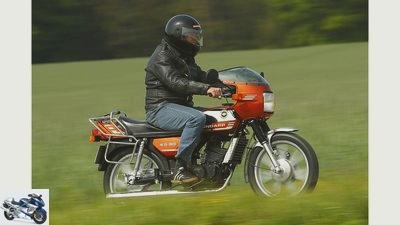
www.bilski-fotografie.de
20/49
Thanks to the dog clutch and more power, the driver finds it the ideal moped for touring, even for longer distances.
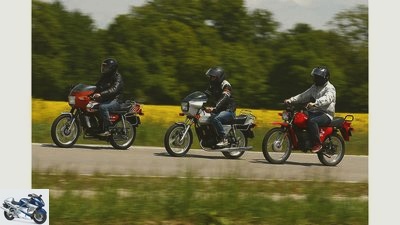
www.bilski-fotografie.de
21/49
German light motorcycles on the move.
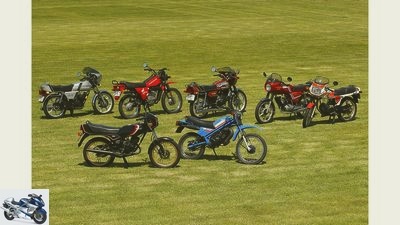
www.bilski-fotografie.de
22/49
Hercules Ultra 80 LC, Kreidler Mustang 80, Zuendapp KS 80, Honda MT 8, Yamaha RD 80 MX, KTM 80 RLW and Puch Cobra 80.
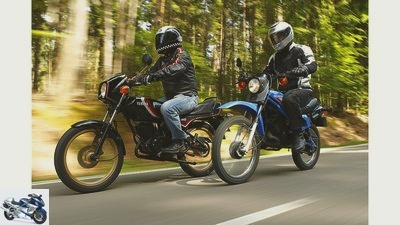
www.bilski-fotografie.de
23/49
The Japanese 80s have more to offer than just the particularly low price with which they manage to conquer the top of the registration statistics in the shortest possible time.
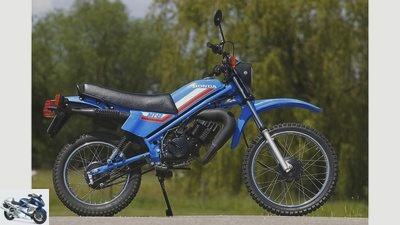
www.bilski-fotografie.de
24/49
Idiosyncratic, but independent: The petite Honda looks almost fragile with the engine hanging in the open frame below.
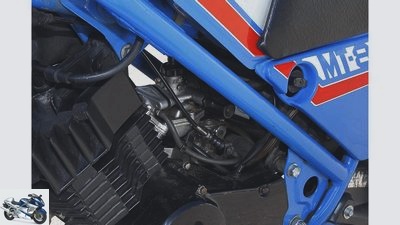
www.bilski-fotografie.de
25/49
The easily accessible choke button on the carburetor only needs to be used briefly during a cold start.
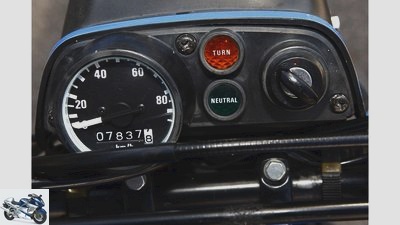
www.bilski-fotografie.de
26/49
In the cockpit only the most necessary displays, but easy to read and brightly lit..
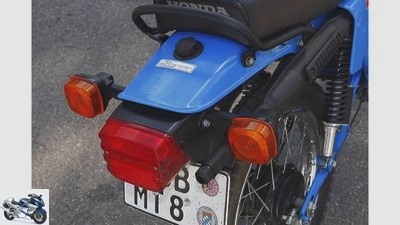
www.bilski-fotografie.de
27/49
The filler neck for the oil of the separate lubrication is located in the rear apron.
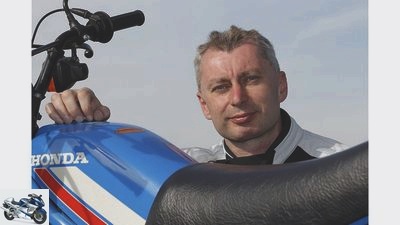
www.bilski-fotografie.de
28/49
Gerhard Eirich editor and driver of the Honda MT-8.
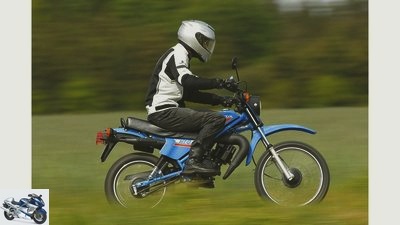
www.bilski-fotografie.de
29/49
Rode the MT-8 myself when he was 17 and would buy it again.
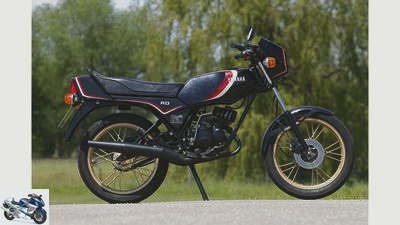
www.bilski-fotografie.de
30/49
As with the 250/350 models, the RD 80 meets the tastes of young buyers with the decor design.
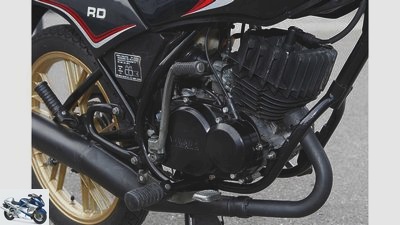
www.bilski-fotografie.de
31/49
Not particularly powerful, not particularly easy to turn, but particularly powerful – the membrane-controlled RD 80 motor.
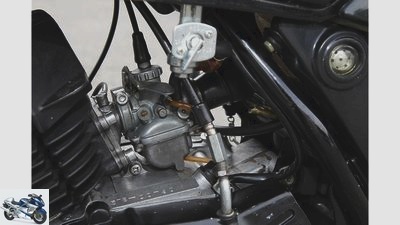
www.bilski-fotografie.de
32/49
The Yamaha also only asked for the easily accessible choke valve on the carburetor to be used.
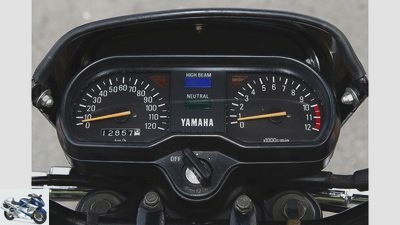
www.bilski-fotografie.de
33/49
The cockpit looks really grown up with its clear design and easy-to-read instruments – like the big RD sisters.
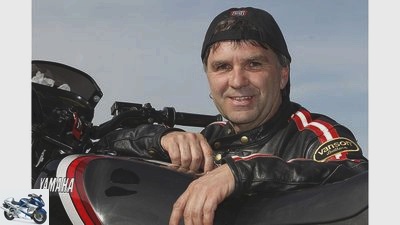
www.bilski-fotografie.de
34/49
Hardy Ruff is the owner of the Yamaha RD 80 MX.
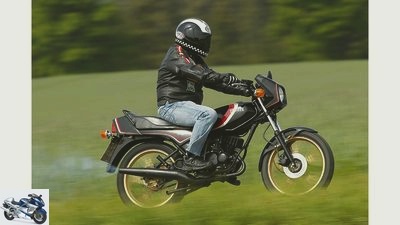
www.bilski-fotografie.de
35/49
The Yamaha RD fan has various Yamaha two-strokes (50s, 350s, etc.) and some other vehicles in the works, but only recently this 80s.
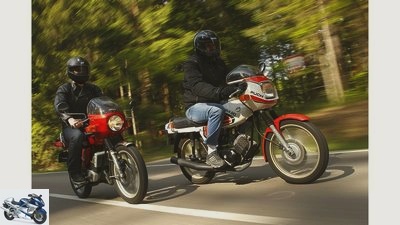
www.bilski-fotografie.de
36/49
Strong, sporty, technically innovative and well equipped – the 80s of Austrian manufacturers enjoy a special image.
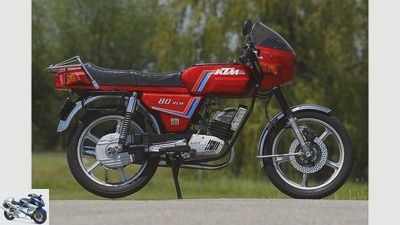
www.bilski-fotografie.de
37/49
The KTM combines a sporty design (fairing, integrated indicators) with practical solutions such as the grease chain case.
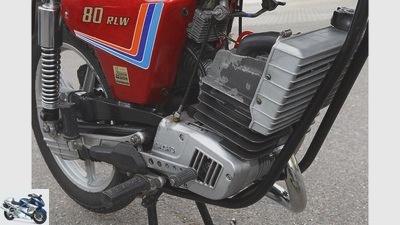
www.bilski-fotografie.de
38/49
The well-proven Sachs engine is used in many cases and is particularly easy to turn in the KTM.
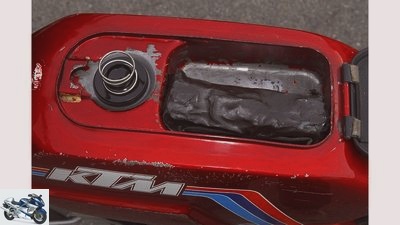
www.bilski-fotografie.de
39/49
The storage compartment, which is hidden under a flap and integrated into the tank, offers space for small items or, if necessary, a raincoat.
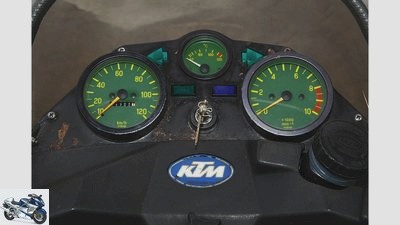
www.bilski-fotografie.de
40/49
In the contemporary VDO cockpit, which is common with Hercules and KTM, there is a speedometer and rev counter as well as a cooling water temperature display.
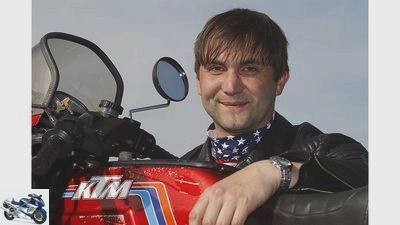
www.bilski-fotografie.de
41/49
Christian Neumeier is the owner of the KTM 80 RLW.
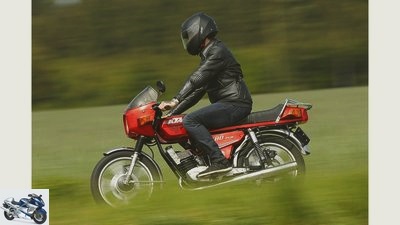
www.bilski-fotografie.de
42/49
Has been interested in old mopeds, mopeds, small and light motorcycles and their technology since he was eleven.
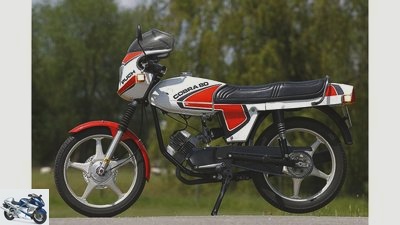
www.bilski-fotografie.de
43/49
The design by Porsche pays off: The Puch usually earns great admiration.
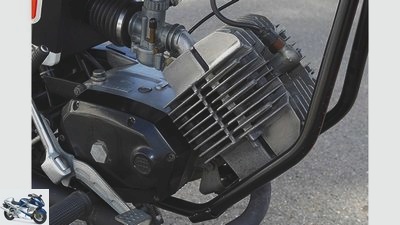
www.bilski-fotografie.de
44/49
Powerful Puch engine with Bing carburetor (with swab) – reliable starter and power on the mountain.
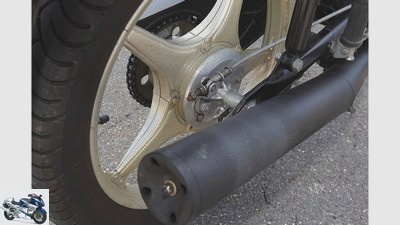
www.bilski-fotografie.de
45/49
The small drum brake in the rear wheel does a great job.
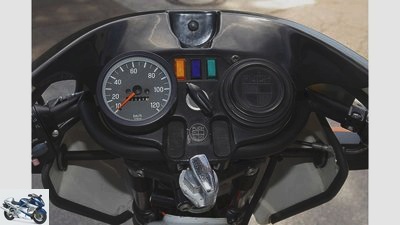
www.bilski-fotografie.de
46/49
The silver helmet holder in the cockpit above the steering head is locked with the steering lock.
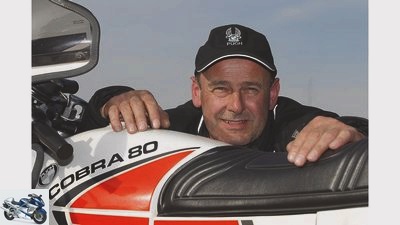
www.bilski-fotografie.de
47/49
Klaus Sauer is the owner of the Puch Cobra 80.
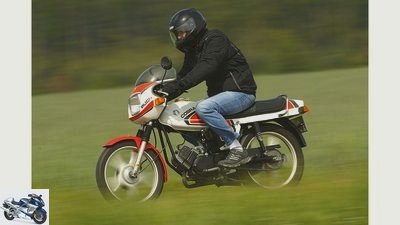
www.bilski-fotografie.de
48/49
At 16 he was already driving Puch. Back then with his girlfriend as a passenger, who is now his wife and drives herself.
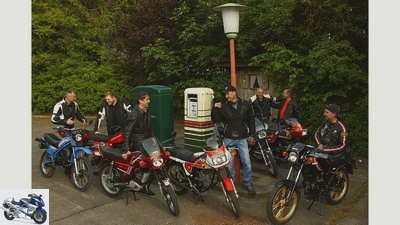
www.bilski-fotografie.de
49/49
The drivers and owners with their 80s bikes.
The first generation of the 80s models on the move
First class 1981
Content of
The 50s are dead, the 80s are alive. The small motorcycle is being replaced by the light motorcycle, and at the beginning of the 1980s a flood of new models came onto the market. MOTORRAD Classic brought together the most important representatives of the premier 1981 vintage for an excursion.
Zage is relative. This has never been as clear to me as in the spring of 1981, when the question arose whether I should crawl around with the mokick for a long year until my eighteenth birthday or still get a class 1b driver’s license and get an 80s. The insurance premiums of over 1000 marks for mopeds were reduced to just over 100 marks per year for the new, less toxic 80s, which were limited to 80 km / h and therefore less accident prone (so the hope), at the start of the new class. Reason lost back then – the 40 km / h disgrace had to come to an end. The new Honda MB-5 was sold and an MT-8 was ordered.
Buy complete article
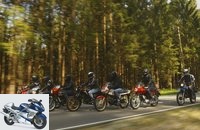
The first generation of the 80s models on the move
First class 1981
Hercules Ultra 80. He is considered to be a late caller, who only got his motorcycle license at the age of 31 and fell into the moped mania a few years ago. Since then he has been driving the Hercules Ultra 80 LC, which currently, after trying to change the jets, twitches a little when starting. With good advice, he hands me the Ultra in exchange for the Honda.
Hercules Ultra 80 LC pulls through strongly
In a sporty, bent posture, leaning on the heavily cranked handlebars, I spur the water-cooled Sachs engine, which is largely based on the 50s. The Hercules Ultra 80 LC pulls through vigorously from low speeds, but is also not afraid of the range beyond the 7000 mark. Shift up, yes, but with care. Although the well-known draw-wedge gear was given new gears and an improved automatic switchgear, which also has an effect, it is still wise to lift the gearshift lever vigorously and sustainably so that the step reliably engages. At full speed the Ultra knows no stopping, and slightly downhill, the clearly oscillating needle of the VDO speedometer easily exceeds the 110 km / h mark. The chassis can easily cope with such a speed, the central tubular frame with screwed beams cannot be disturbed even by longitudinal joints, the Marzocchi fork is designed tightly, but does a good job. When it comes to equipment, the Hercules hardly has anything to complain about, with double disc brakes at the front, which could have a bit more bite, 12-volt electrics and H4 lights keep the competition at a distance here.
This does not only apply to the Kreidler, who with their 6-volt system and the ridiculous 35/35 watt lamp really doesn’t collect any points. Long-legged, broad, almost self-confident, the Kornwestheim native, who was once developed for a seven-figure sum, stands there. The brand was to move away from the moped image, and with the new engine with the now upright cylinder said goodbye to the Kreidler-typical horizontal cylinder. The 80s looks new on the outside, but the innards such as the crankshaft, clutch and gearbox come from the 50s foil RS. The motor hangs at three points in rubber bushings in the frame, which consists of a profile steel central tube and two beams. The eight-hp, slot-controlled motor pulls in very powerfully, and the long gearshifts make the quick gear changes somewhat difficult. But soon violent vibrations are noticeable. The hard and angular bench, which maltreats the buttocks, makes things even more difficult.
Brake the Kreidler Mustang 80 with 12 fingers
Yannic Sauer, who owns the Mustang, is only 17 and tough. At least the robust sound is right, reinforced by the black cover on the tank, which drones along as a resonance chamber. Underneath there is a small storage space, tools and the fuel cap. Sitting very upright in the high saddle, I enjoy the overview of what is happening and can concentrate on taming the load if it gets too easy to stir at a higher speed. When things get critical and braking is the order of the day, the 160-millimeter simplex drum at the front is of no particular help. Two-finger brake? Nothing there, the drum of the Kreidler Mustang 80 is more of a duodenal brake. Fortunately, the rear, easily metered counterpart helps a lot. It is understandable that the Kreidler could not achieve a top position in comparative tests at that time. At 4,300 marks it was also very expensive in 1981.
The Zundapp KS 80 from Robert Bauer, with its new price of 4,150 marks at the time, was only something for the well-heeled. Outwardly, the 80s looks like the old 50s at first glance, but two years of extensive development have borne fruit. Fine-tuning of the seat and rear bumper (with spoiler attachment) is part of it, but above all the completely newly developed, but still mixture-lubricated engine. The slot-controlled 80 still relies on thermosiphon cooling, so it does not require a water pump and uses the exchange effect of the rising warm and the falling cold water. Works – the Zundapp has no temperature problems. Trouble with the switchability of the draw key gear is now a thing of the past, because in the 80s the gears are now sorted by claws and shift drum and click into place crisply and precisely.
Zundapp usually stays on the heels of the Hercules
Otherwise, the Zundapp KS 80 looks as mature as ever, a bit like the S-Class in the field – solid, well equipped (extensive cockpit, easy-to-use handlebar fittings, luggage rack with elastic strap), strong and unobtrusively fast, without riot. You sit relaxed on the seat, the handlebars not too high, not too narrow, the quiet engine pulls evenly through the rev range. Almost unspectacular, and yet the Zundapp KS 80 can usually stay on the heels of the Hercules Ultra 80 LC. Especially on the mountain, the Zundapp proves to be a real puller and climbs slopes in the fifth, where others have long been stirring wildly in the gears. If you wanted to criticize anything at all, then the step backwards to the pillion footrests mounted on the swing arm and the retention of the poor 6-volt electrical system and the mixed lubrication.
The Japanese were on a different path from the start and relied on separate lubrication, i.e. with a separate oil tank and oil pump. Just like the Honda MT-8, which I keep moving every now and then and which I like a lot like back then. The diaphragm-controlled, eight hp two-stroke engine converts its even power development in connection with the short translation into great sprinting ability and nowhere is there any nakedness. Switch? With short lever movements, the gears always lock precisely. Okay, the cockpit is very sparsely equipped, the equipment overall quite poor. Bearable, given the unbeatable low price. But the comfort of sitting on the well-padded bench is also good for long journeys, and vibrations are not an issue thanks to a balance shaft (!) In the engine. Not even at full throttle, which unfortunately is the end of the day with the MT-8 even after starting up at Tacho 85.
After all, I don’t have to worry about going downhill, the puny-looking drum in the front wheel decelerates surprisingly well and only goes to my knees when the load is sustained. Every MT-8 rider was more concerned about the thin fork. On the popular jumping hill, a mound on the railway embankment, my friends used to wait with a smile for the 27-millimeter fork tubes to snap off when landing. Forget it guys. But was the MT-8 so nervous back then at top speed, or am I just spoiled today?
"Hey Smoky, you’ll go all the way back afterwards, yes?"
We stop for the next photo stop, a group picture is due. The first taunts arise, just like before. There is talk of rice cookers, and well-intentioned advice comes from the German corner. “The Yamaha has to stand further to the right.” “But there it is no longer in the picture.” “Yes, just.” As it was before, when the camps were mostly insurmountably divided.
How does the Yamaha RD 80 MX, which was scolded at the time as weak, with its 6.8 hp? I trade again and take over the moped from Hardy Ruff. The Yamaha steals the design quite unabashedly from the big sisters RD 250/350 LC and makes a quite adult impression even when stationary. Cockpit, switch – everything looks solid, motorcycle-like, the cantilever swing arm with the central spring strut is technically impressive. When it comes to sound, the RD also has its pants and blares its two-stroke sound loudly and unabashedly from the RD-shaped exhaust. The latter, incidentally, also dismisses the thickest blue two-stroke flag, and the blasphemy group quickly created a new nickname for the Yamaha owner. “Hey Smoky, you’re going to go all the way back afterwards, okay?”
Later. First I swing myself into the RD saddle and give smoke signals. In addition to the Zundapp, the Yamaha RD 80 MX offers perhaps the most relaxed gentlemen’s riding posture, a bit like on a big bike – just in a small size. Loud, but otherwise very well-mannered, the Yamaha moves with little gas, doesn’t feel so weak at all. It is almost as light as the Honda, almost as handy, but much less nervous. The second cheapest 80s in the field at 2795 marks offers a surprising amount for the money. Well-appealing spring elements, a fairly stable chassis, a foldable bench seat with access to the storage space under the rear bumper, instruments that are easy to read. Comfortable: The test in MOTORRAD confirmed at the time that the RD speedometer is lagging slightly. Tacho 80 are real 83 – that makes up for a frustrated look at the display. Headwind or inclines let the RD fall back immediately. But it can take longer, and you will be billed at the end. Thanks to the 13 liter tank, at the end of the day I will rush past the tank with the Yamaha waving and waving, where Honda (small tank), KTM (drinks like a hole) and Co. are gasping for fuel at the pump. Simply a great everyday moped, the RD.
KTM with high quality equipment and technology
The KTM 80 RLW, which I switch to at the next stop, has a higher standard. A sporty look, technical finesse, good driving performance – Christian Neumeier, actually a Zundapp fan and collector, has always fascinated the Austrian. So he couldn’t help but be offered the clearly numbered 80 RLW that had been forgotten in the shed. “I’ll give it to you, otherwise it goes in the bin”. Christian has technically overtaken the KTM, but has left the traces of its past.
The equipment and technology are of high quality and justify the then high price of 4,349 marks. Instead there was a disc brake at the front and rear, a closed grease chain box, a storage compartment integrated in the tank, a 12-volt system, H4 headlights and die-cast magnesium rims. And of course the well-known water-cooled Sachs engine as in the Hercules, with the same gearbox but a different secondary ratio. So here, too, start with your left hand, the engine is snappy on the gas, the deep handlebar stubs force you into the correct riding position. The KTM pulls out properly from below, but it only shows its true nature from 5500 rpm, where it energetically increases, revs up jaggedly and makes its sporting demands clear. The view into the cockpit falls on the usual VDO instruments, but supplemented by a cooling water temperature display. The engine usually never gets too hot, and if the driver is too hot-headed, he can rely on an enormously snappy front brake. Two fingers are enough to bring the fork to your knees. It is a matter of honor for the KTM chassis that nothing wobbles even at full throttle and on a bad road. The comfortable bench also deserves praise.
"Was the tachometer not series?"
On this point, however, she has to admit defeat to the second Austrian, the Puch Cobra 80. Their softly padded, but not spongy seat makes practically everything perfect, as I noticed immediately after switching from the KTM. Almost all of us dreamed of a Puch back then: She was an expensive exotic woman and therefore seldom found. Their design developed by Porsche and the six-speed gearbox made us astonished.
I am now experiencing its vaunted torque first hand – it’s great how the 8.4 hp engine hangs on the gas, revs up evenly with power and fights its way up even long climbs tenaciously in sixth. One of the six available gear steps is always suitable for steep mountains. The bent posture is slightly sporty, but still comfortable, the ergonomics fit. The suspension setup, too, the fork and five-way adjustable struts swallow everything that gets under the wheels. Downhill the speedometer needle moves in the direction of the 100 km / h mark, before the impending roundabout it is advisable to grab the brake lever that protrudes far. The effect of the disc could be crisper, the rear drum reliably helps here. The Puch can be zigzagged around the top, precise and stable – nothing burns here. When you accelerate out of the way, your eyes look for the rev counter and go nowhere. Wasn’t that a series? “I bought it first-hand from a dealer who just drove around the yard with it. Is it an early ‘economy model’? ”Owner Klaus Sauer is not sure. He just had to buy the little-used Cobra in this condition and keep it alive.
The class of the fast 50s did not survive back then, neither did the 80s – the cult around the small and light motorcycles, however, is more alive than ever. And my memories of 1981 have been so since today.
Hercules Ultra 80 LC
- engine: Water-cooled single-cylinder two-stroke engine, slot-controlled, bore 46 mm, stroke 48 mm, 79.8 cm³, compression 10: 1, 8.5 HP at 6000 / min, max. Torque 10 Nm at 6000 rpm, Bing carburettor, Ø 20 mm, multi-disc oil bath clutch, five-speed gearbox, draw-wedge gear, chain drive
- landing gear: Central tubular frame with bolted beams, telescopic fork, two-arm swing arm with two spring struts, double disc brake at the front, Ø 220 mm, drum brake at the rear, Ø 140 mm, front and rear tires 2.75-17
- Tank capacity: 14 liters
- Weight: 110 kG
- Prize 1981: 4350 marks
- construction time: 1981-1983
Kreidler Mustang 80
- engine: Air-cooled single-cylinder two-stroke engine, slot-controlled, bore 46 mm, stroke 48 mm, 79.8 cm³, compression k. A., 8 hp at 6000 rpm, max. Torque 9 Nm at 6000 rpm, Bing carburettor, Ø 20 mm, multi-disc oil bath clutch, five-speed gearbox, dog clutch, chain drive
- landing gear: Central tubular frame with two beams, telescopic fork, two-arm swing arm with two spring struts, drum brake front / rear, Ø 160/120 mm, tires front 2.50-19, rear 3.00-17
- Tank capacity: 10 liters
- Weight: 95 kg
- Prize 1981: 4300 marks
- construction time: 1981-1982
Zundapp KS 80
- engine: Water-cooled single-cylinder two-stroke engine, slot-controlled, bore 46 mm, stroke 47 mm, 78 cm³, compression 11.2: 1, 8.7 HP at 6000 / min, max. Torque 10.8 Nm at 5500 rpm, Bing carburetor, Ø 20 mm, multi-disc oil bath clutch, five-speed gearbox, dog clutch, chain drive
- landing gear: Central tubular frame with bolted beams, telescopic fork, two-arm swing arm with two spring struts, front disc brake, Ø 220 mm, rear drum brake, Ø 150 mm, front and rear tires 2.75-17
- Tank capacity: 13.5 liters
- Weight: 105 kg
- Prize 1981: 4150 marks
- construction time: 1981-1983
KTM 80 RLW
- engine: Water-cooled single-cylinder two-stroke engine, slot-controlled, bore 46 mm, stroke 48 mm, 79.8 cm³, compression 10: 1, 8.5 HP at 6000 / min, max. Torque 10 Nm at 6000 rpm, Bing carburettor, Ø 20 mm, multi-disc oil bath clutch, five-speed gearbox, draw-wedge gear, chain drive
- landing gear: Central tubular frame with bolted beams, telescopic fork, two-arm swing arm with two spring struts, disc brakes front and rear, Ø 245 mm, front and rear tires 2.75-17
- Tank capacity: 11.5 liters
- Weight: 107 kg
- Prize 1981: 4349 marks
- construction time: 1981-1987
Puch Cobra 80
- engine: Air-cooled single-cylinder two-stroke engine, slot-controlled, bore 50 mm, stroke 39.7 mm, 77 cm³, compression 11.8: 1, 8.4 HP at 5900 rpm, max. Torque 10.1 Nm at 5800 rpm, Bing carburetor, Ø 20 mm, multi-disc oil bath clutch, six-speed gearbox, dog clutch, chain drive
- landing gear: Central tubular frame with two beams, telescopic fork, two-arm swing arm with two spring struts, front disc brake, Ø 220 mm, rear drum brake, Ø 140 mm, front tires 2.50-17, rear 3.00-17
- Tank capacity: 12.5 liters
- Weight: 100 kg
- Prize 1981: 3495 marks
- construction time: 1981-1988
Yamaha RD 80 MX
- engine: Air-cooled single-cylinder two-stroke engine, diaphragm-controlled, bore 49 mm, stroke 42 mm, 79 cm³, compression 6.4: 1, 6.8 HP at 6000 / min, max. Torque 8 Nm at 5000 rpm, Teikei carburetor, Ø 16 mm, multi-disc oil bath clutch, five-speed gearbox, dog clutch, chain drive
- landing gear: Tubular frame with forked beam, telescopic fork, cantilever swing arm with central spring strut, front disc brake, Ø 203 mm, rear drum brake, front tires 2.75-18, rear 3.00-18
- Tank capacity: 13 liters
- Weight: 95 kg
- Prize 1981: 2795 marks
- construction time: 1981-1982
Honda MT-8
- engine: Air-cooled single-cylinder two-stroke engine, diaphragm-controlled, bore 45 mm, stroke 49.5 mm, 78 cm³, compression 7.8: 1, 8 HP at 6000 / min, max. Torque 9.4 Nm at 5500 rpm, Mikuni carburettor, Ø 18 mm, multi-disc oil bath clutch, five-speed gearbox, dog clutch, chain drive
- landing gear: Double loop frame of straight path design, telescopic fork, two-arm swing arm with two spring struts, drum brake front and rear, Ø 110 mm, front tires 2.50-19, rear 3.00-16
- Tank capacity: 6.8 liters
- Weight: 89.5 kg
- Prize 1981: 2550 marks
- construction time: 1981-1984
The cult in words and pictures
This book (see picture) by Frank O. Hrachowy, ISBN 9783935517591, offers a brilliant overview of the range of light motorcycles with lots of information and numerous pictures for 34 euros. Rare, little-known 80s models from exotic brands can also be found here, as well as the entire history of the 80s from the steep rise to the decline of the class.
Worthwhile Websites:
- www.die-kleinkraftrad-ig.de, where a book about the 80s can be downloaded free of charge or a printed copy can be purchased for 16 euros.
- www.sonnengelber.de
- www.moped-museum.de
- www.schluchtenflitzer-sob.de
Related articles
-
Generation comparison: lightweight motorcycles
Jahn Generation comparison: lightweight motorcycles Lightweight bikes in comparison Content of A man builds a dream. Rudiger Kranz is a lightweight…
-
Zongshen Cab 125 Next Generation review
Zongshen Cab 125 Next Generation review Hermaphrodite beings Scooter or motorcycle? The answer is simple and simple: a bit of both. Far East…
-
Generation comparison: Honda RVF 750, Fireblade, Yamaha YZF-R7, YZF-R1
fact Generation comparison: Honda and Yamaha Superbikes then and now in comparison Content of What can the noble homologation models of the Superbike…
-
Concept comparison: inexpensive motorcycles
Concept comparison: Inexpensive motorcycles A. P Attractive and inexpensive, that’s them. The Aprilia Pegaso 650 Garda, the Kawasaki W 650, the Suzuki SV…
-
On tour with five long-term test motorcycles
On tour with five long-term test motorcycles Nobody at home What does the MOTORRAD long-term test fleet actually do? Kilometre ?? what else. BMW F 650…
-
Comparison test: touring motorcycles
fact 39 pictures fact 1/39 But now to the tourer bikes. The entry-level is the BMW R 1200 RT, which despite its mediocre engine with high-quality equipment, …
-
Comparative test of six-cylinder motorcycles
fact 48 photos fact 1/48 Diagonally around the corner until it scratches: The Honda Gold Wing F6B is very easy (fast) to drive. fact 2/48 Uninformed only…
-
KTM and Husqvarna motorcycles in supermoto style
fact 12 pictures fact 1/12 Supermoto funbikes: KTM 990 SM R and Husqvarna Nuda 900 R in a comparison test. Can the Nuda oust the class leader from the throne? …
-
Generation comparison: BMW GS models
Jahn 24 photos Jahn 1/24 A comparison of four generations of the BMW GS family is intended to examine the progress made over the decades. Jahn 2/24 R 80…
-
Eight large touring motorcycles in a comparison test
Photo: 24 photos 1/24 BMW R 1200 GS Rallye, Moto Guzzi Stelvio 1200 8V, Triumph Tiger Explorer, KTM 990 Adventure, Kawasaki…